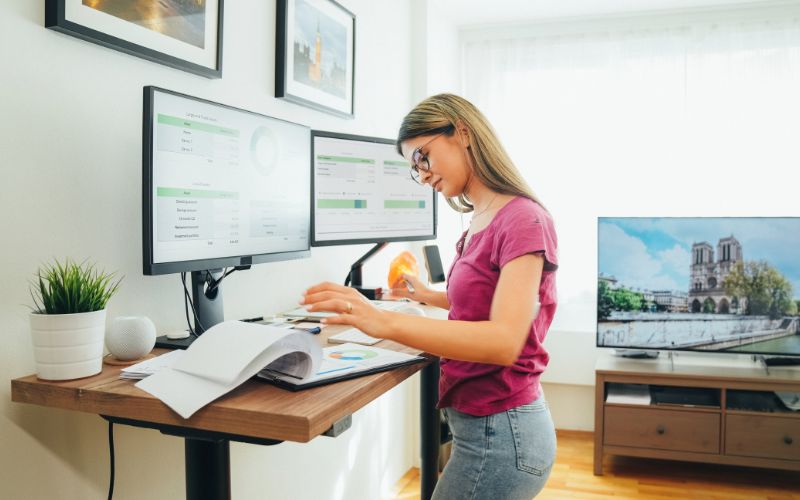In today’s modern world, the majority of us spend our days sitting in front of computers, working for long hours without taking breaks. This sedentary lifestyle can lead to various health issues such as back pain, neck stiffness, and poor posture. Fortunately, there are several ergonomic exercises that can help prevent these problems and improve our overall health.
In this article, we will discuss the top 8 ergonomic exercises that can help you maintain good posture, reduce discomfort, and increase productivity.
Ergonomic Exercises
Neck Rolls
One of the most common ergonomic issues is neck stiffness or pain. Neck rolls are a great way to relieve tension and improve flexibility in your neck muscles. Follow these simple steps to perform neck rolls:
- Sit up straight and place your hands on your thighs.
- Slowly tilt your head towards your left shoulder until you feel a stretch on the right side of your neck.
- Hold this position for 10 seconds and then roll your head downwards towards your chest.
- Continue rolling your head towards your right shoulder and hold for 10 seconds.
- Roll your head back to the starting position and repeat the exercise 5 times.
Shoulder Shrugs
- Shoulder shrugs can help relieve tension and discomfort in your upper back and neck muscles. Here’s how to perform this exercise:
- Sit up straight and relax your shoulders.
- Slowly raise your shoulders towards your ears, and hold for a few seconds.
- Release your shoulders back down to the starting position.
- Repeat the exercise 10 times.
Chest Stretches
Sitting for long hours can cause your chest muscles to become tight, leading to poor posture and discomfort. Chest stretches can help you relieve tension in these muscles. Follow these simple steps:
- Stand up straight and interlock your fingers behind your back.
- Slowly raise your arms upwards, keeping your palms facing downwards.
- Hold this position for 10 seconds and then release.
- Repeat the exercise 5 times.
Hip Flexor Stretch
Prolonged sitting can cause your hip flexors to become tight, leading to lower back pain and discomfort. Hip flexor stretches can help alleviate these issues. Follow these simple steps:
- Stand up straight and take a lunge forward with your left foot.
- Slowly lower your right knee to the ground and keep your left knee at a 90-degree angle.
- Hold this position for 10 seconds and then switch sides.
- Repeat the exercise 5 times.
Seated Spinal Twist
- The seated spinal twist can help improve your posture and reduce lower back pain. Follow these simple steps:
- Sit up straight and place your right hand on your left knee.
- Slowly twist your torso towards the left, using your left hand to support your back.
- Hold this position for 10 seconds and then switch sides.
- Repeat the exercise 5 times.
Standing Calf Stretch
- Sitting for extended periods can also lead to tightness in your calf muscles. This stretch can help alleviate tension and improve your circulation. Follow these steps:
- Stand facing a wall, and place your hands on the wall at shoulder height.
- Step your right foot back, keeping your heel on the ground.
- Lean forward until you feel a stretch in your calf muscle.
- Hold this position for 10 seconds and then switch sides.
- Repeat the exercise 5 times.
Ankle Rolls
This exercise can help relieve stiffness and tension in your ankle joints. Follow these steps:
- Sit up straight and cross your right leg over your left.
- Slowly rotate your right ankle in a clockwise direction for 10 seconds.
- Reverse the direction and rotate your ankle counterclockwise for 10 seconds.
- Switch sides and repeat the exercise 5 times on each side.
Standing Figure-Four Stretch
- This stretch can help improve flexibility in your hips and relieve discomfort in your lower back. Follow these steps:
- Stand up straight and cross your right ankle over your left knee.
- Slowly bend your left knee and lower your hips towards the ground.
- Hold this position for 10 seconds and then switch sides.
- Repeat the exercise 5 times on each side.
Incorporating ergonomic exercises into your daily routine can help prevent workplace injuries, improve your posture, and boost your productivity. We hope that these top 10 ergonomic exercises will help you feel better and work smarter. Remember to take breaks throughout the day to perform these stretches, and consult with a medical professional if you have any concerns about your physical health.
FAQ
You can perform these exercises as often as you need to throughout the day. We recommend taking a break every 30-45 minutes to perform a few stretches.
Yes, ergonomic exercises can help prevent workplace injuries by reducing tension and discomfort in your muscles and joints.
Yes, several exercises are specifically designed for desk workers, such as neck rolls, shoulder shrugs, and wrist flexor stretches.









